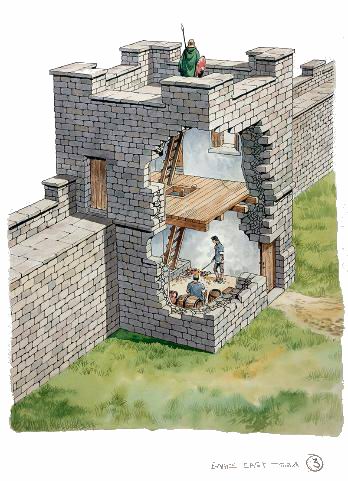The Roman Conquest of Britain
Category: 00 Roman BritainOne of the last countries to be conquered by Rome was France, or Gaul as it was then called. The war against the Gauls, who were Celtic tribes, lasted for eight years. Julius Caesar was appointed Head of the Roman army which was sent to conquer Gaul. In the course of his campaigns Caesar reached the Channel and that was how the Romans came to see the white cliffs of the land of the British Celts.
In 55 B.C. a Roman army of 10,000 men crossed the Channel and invaded Britain. The Celts saw their ships approaching and rushed to attack the invaders in the sea as they were landing. The Celts made a great impression on the Romans, who saw them for the first time in battle. On the occasion of the battle their hair and moustaches were dyed red and their legs and arms were painted blue. With loud shouts they attacked the Romans in chariots and on foot and the well-armed invincible Romans under one of the greatest generals of that time had to return to Gaul.
In the next year, 54 B.C., Caesar again came to Britain, this time with larger forces (25,000 men). The Cells fought bravely for their independence but they were not strong enough, in spite of their courage, to drive the Romans off. The Romans who had better arms and armour and were much better trained defeated the Celts in several battles. Some of the chiefs submitted and promised to pay tribute to Rome. Caesar then went back to Gaul to complete his conquest on the Continent.
Although Julius Caesar came to Britain twice in the course of two years, he was not able, really, to conquer it. The promised tribute was not paid and the real conquest of Britain by the Romans was not begun until nearly a hundred years after Caesar’s visits to the island.
 In 43 A. D. a Roman army invaded Britain and conquered the South-East. Other parts of the country were taken from time to time during the next forty years. The hilly districts in the West were very difficult to subdue, and the Romans had to set up many camps in that part of the country. The Celts fought fiercely against the Romans who never managed to become masters of the whole island. They were unable to conquer the Scottish Highlands and the province of Britain consisted only of the southern part of the island. From time to time the Piets from the North managed to raid the Roman part of the island, burn their villages, and drive off their cattle and sheep.
In 43 A. D. a Roman army invaded Britain and conquered the South-East. Other parts of the country were taken from time to time during the next forty years. The hilly districts in the West were very difficult to subdue, and the Romans had to set up many camps in that part of the country. The Celts fought fiercely against the Romans who never managed to become masters of the whole island. They were unable to conquer the Scottish Highlands and the province of Britain consisted only of the southern part of the island. From time to time the Piets from the North managed to raid the Roman part of the island, burn their villages, and drive off their cattle and sheep.
To defend their province the Romans stationed their legions in Britain. Straight roads were built so that the legions might march quickly, whenever they were needed, to any part of the country. These roads were made of several layers of stones, lime, mortar and gravel. They were made so well that they lasted a long time and still exist today. Bridges of stone were built wherever a road crossed a river; some of these bridges can still be found in Britain today. Besides, to guard the province against the Piets and Scots who lived in the hills of Scotland a high wall was built in the North. It was called “Hadrian’s Wall” because it was built by command of the Emperor Hadrian. From one end of the wall to the other forts were built a mile apart and the Roman warriors could be seen marching up and down the whole length of the wall. When the Northern Britons were not at war with the Romans they often came to the wall and traded with the warriors and the Romans would go hunting in the region north of the wall.
